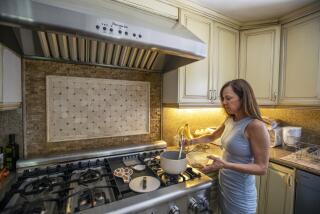To a Degree, Thermometers Make Foods Safe
- Share via
Many people think they can tell when a food is done just by looking at it, points out a recent issue of the FDA Consumer, an interesting magazine published by the U.S. Food and Drug Administration.
But food-safety experts report that one out of four hamburgers, for example, will turn brown (and thus appear to be fully cooked) well before it reaches a temperature high enough to have destroyed the harmful bacteria. This often happens because freezing and thawing may influence a meat’s tendency to brown prematurely, and it can be a real recipe for food poisoning.
Bacteria tend to grow slowly at low temperatures (like those in the refrigerator) but quickly at mid-range temperatures (sitting around or undercooked). In order to be really safe, cooked food must reach an internal temperature high enough to kill all the harmful bacteria.
One good way to make sure your food is well cooked and safe is to use a meat thermometer. However, a government survey conducted a couple of years ago showed that less than half of the population owned a meat thermometer and that only 3% actually used it when cooking particularly susceptible foods like hamburgers.
The U.S. Department of Agriculture recently started a campaign to promote wider thermometer use and set up a helpful Web site with an oh-so-cute cartoon character named “Thermy.” Thermy is going to be appearing in grocery stores nationwide with important food-safety messages, such as the proper temperatures for cooked foods:
* 145 degrees Fahrenheit for medium rare beef, lamb and veal steaks and roasts (160 degrees for medium).
* 160 degrees for ground beef, pork, veal and lamb; pork chops, ribs and roasts; and egg dishes.
* 165 degrees for ground turkey and chicken, stuffing and casseroles or leftovers.
* 170 degrees for chicken and turkey breasts.
* 180 degrees for whole chickens and turkeys, legs, thighs and wings.
Using a thermometer to check the temperature of foods is not difficult, but the thermometer has to be calibrated correctly and inserted into the right area of the food. Generally speaking, the thermometer should go into the thickest part of the food, away from any bone, fat or gristle. The manufacturer will have provided instructions on how to check the accuracy of the thermometer.
There are now several types of thermometers on the market, ranging from the simple and old-fashioned to some new high-tech models:
* Liquid-filled thermometer: This will take one to two minutes and needs to be put 2 inches deep into the thickest part of the food. It is best used on roasts, casseroles and in soups. It can be placed in the food while cooking, but it cannot measure the temperature of thin foods. The calibration cannot be adjusted, and it is possible for the thermometer to break while in the food. In addition, heat conduction of the metal shield can cause a falsely high reading.
* Bimetal (oven-safe) thermometer: This type of thermometer takes one to two minutes and needs to be inserted 2 to 2 1/2 inches into the thickest part of the food. It is best used in roasts, casseroles and soups. It can be used while cooking but is not appropriate for thin foods. The heat conduction of the metal stem can cause a falsely high reading.
* Bimetal (instant-read) thermometer: This works within 15 to 20 seconds and must be inserted 2 to 2 1/2 inches deep into the thickest part of the food. It is best when used on roasts, casseroles and soups. It can be calibrated but cannot be used in the oven while cooking food. It will only check the internal temperature of food at the end of the cooking time. Unless it is inserted sideways, it will not measure thin foods. The temperature is averaged along 2 to 3 inches of the probe.
* Thermistor thermometer: This thermometer works in only 10 seconds and needs to go only half an inch deep. That makes it good for hamburgers and chops. It has a digital readout and must be used after cooking; it cannot be used in the oven.
* Thermocouple thermometer: The fastest of all, this unit takes only five seconds and needs to go only a quarter-inch deep. It is perfect for burgers and chops. It can be calibrated, will quickly measure even the thinnest of foods and has a digital readout.
The cost of these thermometers is, of course, directly related to their degree of flexibility and accuracy, but none of them is expensive. With proper care, they’ll all last for quite a while, and in any case it seems a small price to pay to ensure that you aren’t the one to poison your family.
The USDA’s food safety Web site is https://www.fsis.usda.gov/thermy/. It has great games and educational materials for kids and links to other good information on food safety. If you’re not a Web-site kind of person, call the department’s toll-free meat and poultry hotlines at (800) 535-4555 and (800) 256-7072 (TDD/TTY). They’re good places to get some information before the holiday-cooking glut is upon us.
*
Dr. Sheldon Margen is a professor of public health at UC Berkeley; Dale A. Ogar is managing editor of the UC Berkeley Wellness Letter. Send questions to Dale Ogar, School of Public Health, UC Berkeley, Berkeley, CA 94720-7360, or e-mail to daogar@uclink4.berkeley.edu. Eating Smart appears the second and fourth Mondays of the month.
More to Read
Eat your way across L.A.
Get our weekly Tasting Notes newsletter for reviews, news and more.
You may occasionally receive promotional content from the Los Angeles Times.










